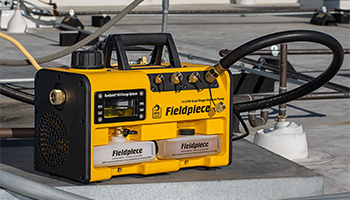
By: Tony Gonzalez, Technical Training Manager at Fieldpiece
Pulling a vacuum before adding refrigerant can be a time-consuming process but removing all moisture and non-condensable gasses is an important step that quickly pays for itself. Plus, making sure your system can hold a vacuum at targeted microns per manufacturer recommendations (with a general rule of thumb being 500 microns) helps ensure it isn’t leaking. Here are a few tips that may help save you some time on your next evacuation:
Choose the Right Tool.
First, start by using the best tool for the job and then make sure you put it in the right spot. Not everyone realizes that a stand-alone vacuum gauge is the best tool to measure a deep vacuum. Along with being incredibly accurate, a vacuum gauge can be positioned in the ideal location — as far back on the system from the pump as possible. This best practice helps you ensure it’s placed in the last spot to reach your targeted vacuum level; and by placing it directly on the system—if you do detect a leak—you can be sure that the problem is in the system itself since you can rule out an issue in an extraneous hose or attachment.
Clear Any and All Flow Restrictions.
Next, make sure to clear any flow restrictions in the system. It may seem easy to use a pair of charging hoses to pull a vacuum, but vacuum-rated hoses have a larger diameter and typically lack a core depressor. They are designed to facilitate maximum flow during evacuations, which means your job is done faster and easier. You should also remove the valve cores from the service ports on the system. These steps can help clear restrictions and speed up evacuations.
Check Your Oil Condition.
Something else to keep in mind is clean oil. Dirty oil that’s saturated with water is less effective at removing moisture and other non-condensables from the system. Also, oil oxidizes over time and this reduces its sealing properties. Changing the oil often significantly speeds up the evacuation time.
Certain HVAC vacuum pumps enable oil changes, even while the pump is still running. This allows you to make oil changes on the fly, quickly and easily, without a mess, loss of vacuum, or time.
Take Guesswork Out of the Equation.
As you’re pulling the vacuum, keep an eye on the vacuum gauges and don’t play it by ear. We all know about how long evacuations should take and you could be tempted to look at a clock and say, “it’s been 30 minutes, we’re probably good.” But, as master craftsmen, we don’t guess. Check the gauge to make sure you’re pulling and holding a vacuum to the manufacturer’s specifications. This is the only way to be sure it’s done right.
Pulling a vacuum to remove moisture and other impurities is key to preserving the overall health of the system. Since it’s the single most important step to ensuring a system’s optimal performance and longevity, knowing how to perform evacuations quickly and correctly is an important skill to master. We hope these tips have been helpful!
About the Author: Tony Gonzalez is the Technical Training Manager for Fieldpiece Instruments. He has more than 20 years of industry experience with Fieldpiece developing new products. Most recently, he led the Job Link® App development team and developed Fieldpiece’s wireless power clamp meters. He is committed to training on best practices to help the HVACR professionals do their job easier, faster, and better. Tony enjoys road cycling and rooting for his hometown LA Dodgers.
Featured in: HVAC/P Magazine